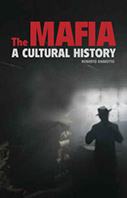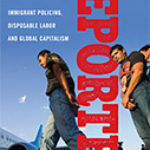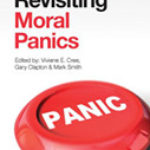The Mafia: A Cultural History

Author: Roberto M. Dainotto
Publisher: London: Reaktion Books, 2015. 239p.
Reviewer: Jay Albanese | May 2016
This book is largely about portrayals of the Mafia in film, so the title does not quite describe the contents of the book. The book focuses on movies, focusing especially on The Godfather trilogy, Scarface (1932) and the Sopranostelevision series. The author, born and raised in Sicily, raises the question, “What made me love the Mafia in fiction, while loathing the one in real life?”
This book focuses exclusively on the Sicilian and Italian Mafia, and does not address other organized crime groups in Italy or around the world (except for a segment on the Camorra near the end of the book). As the author notes, “It is not a history book,” but an attempt to “trace a history of the Mafia’s growth into our cultural imaginary.” (p.11).
The first chapter aimed at “The Origins of the Mafia,” recounts instead the making of the movie Godfather Part III by Francis Ford Coppola. It focuses on the closing scene of that film which uses the opera Cavalleria Rusticana by Mascagani as background. The author attempts to link it to the life of Giovanni Verga, the 19th century author who wrote the story that formed the basis for the opera. A tenuous effort is made to link the opera’s story (about a returning soldier to Sicily who finds his love has married another, ending in a duel). This is then connected to the imagery of the Mafia for which the author uses historical materials to couple the term ‘mafia’ to the late 1800’s.
Chapter 2 is centered largely on the making of the film Scarface (1932) and Little Caesar (1931). This is where the book is most interesting in eliciting the historical context and specific events that surrounded important mafia movies of the past—which were often controversial at the time they were made. The author notes that the lead in this film, (Tony Camonte) was a thinly disguised Al “Scarface” Capone, and how there was pressure to depict the mafia as an unsuccessful group. “The typical Mafia movie of the 1920s and 1930s” entailed a simple paradigmatic plot – the hero rises to the top, remains isolated, and dies alone to the end” (p. 71). Both film censors and the public at large liked this formula to both blame someone for the Depression, and to show how it is not possible to short-cut one’s way toward the American Dream.
Chapter 2 further places a discussion of movie productions in Italy and the United States during the 1930s and 1940s in juxtaposition with the contemporary political scene at the time. The author concludes that is it “likely that the Mafia had a lesser role during the Fascist regime, since some of the ‘services’ it had traditionally provided were no longer needed” (p. 89).
It is asserted that the movie The Valachi Papers (1972) “is a brilliant cinematic reconstruction of the testimony.” Others would argue that the film made an interesting book and scenario into a boring movie. This points to a larger issue in using art to inform history and vice versa. It is often unclear which is imitating the other. For example, the author makes statements about the organization of the “five families” of the Mafia, an account that has not been supported by a number of other historical accounts (p. 92). A meeting in Palermo in 1957 among alleged mafia figures is not sourced, and the Apalachin meeting in New York State is characterized as “a key moment in the birth of the modern Cosa Nostra” (p. 111). This is not true — as multiple historical accounts have found.
Chapter 4 focuses on the making of the movie The Godfather (1972). There is a good account of the Italian-American protest of the movie at the time and how changes were made to avoid using the terms Mafia or Cosa Nostra in the movie.
Other statements simply do not hold up. For example, it is stated that Joe Valachi “decided, for reasons that are still unclear, to become an informer” (p. 120). The reasons for his coming forward are well-documented. (He killed another inmate in prison and was looking to escape a death sentence, while at the same time the Attorney General was looking for new prosecution tools against organized crime.)
Chapter 5 focuses primarily on the Sopranos television series of the 1980s, and the lesser known Italian series The Octopus, preceded by an account of the many mafia-related killings in Italy during that period. There is also mention of several made-for-television mafia movies. As in the previous chapters, an effort is made to link events in the fictional portrayals to historical mafia-related activity.
Chapter 6, the final chapter, discusses more recent films, such as Gomorrah (2008), and its weak connection to the non-fiction book of the same name. It recounts the debate over the portrayals in the book of the Camorra made by its author. “Was Gomorrah the original, unadulterated truth about the Camorra, or a fake novelistic allegory of globalization?” (p. 196).
In sum, the author’s focus is on the confusion, both in film and in real life, “[b]etween a real Mafia and an ideal or operatic one” (p. 200). In the last few pages, the video game, Mafia II, is used to illustrate how mafia imagery “allows for both identification and repulsion on the part of the reader or viewer” (p. 201). For those interested in movies and television portrayals of Italian-American organized crime, this book provides some little-known information about many films and television portrayals and their historical circumstances.
One cannot read a book that discusses organized crime in film without addressing favorite movies; the author says that Giordano’s filmOne Hundred Steps (2000) is the most “realistically representative” of any mafia movie or book. For me, it is Goodfellas (1989), based on a book by a mafia informant, which the author mentions in passing, but does not devote any time to discussing.
Jay S. Albanese, Professor, Virginia Commonwealth University, Wilder School of Government & Public Affairs


